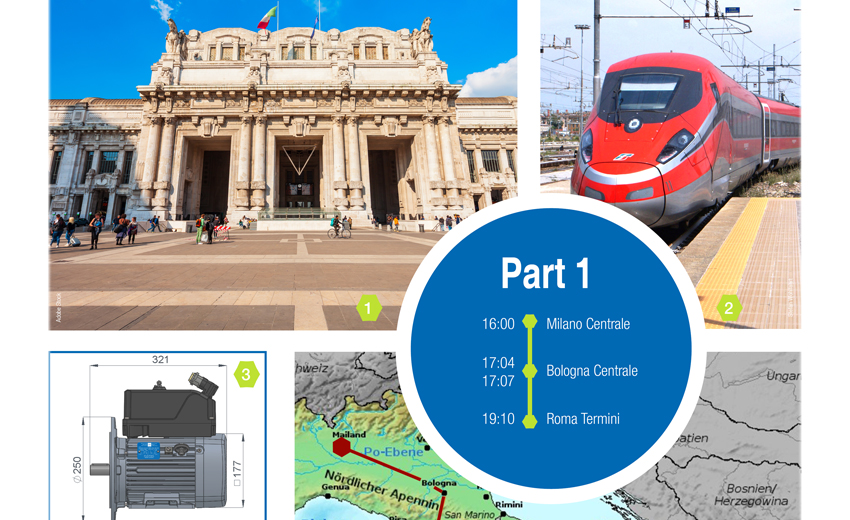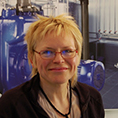 14.01.2022
14.01.2022
The Italians call it The Red Arrow
High-tech drive system for rail vehicles: part 1 – …
VEMoDRIVE: Speed-controlled drive system for rail
Milan central station: it’s 4pm and one of Europe’s fastest trains, the Frecciarossa1000, is waiting on platform 1 for the conductor to give the signal to depart. I would like to go to Rome. After a transit time of three hours and 10 minutes, the passengers will leave the train at the Termini station in Rome. It used to take at least six hours to cover the 477km route.
The Italians are very proud of their ‘red arrow’, the Frecciarossa1000. The design resembles that of an Italian sports car. And like a sports car, it oozes world-class high tech – looking very modern on the outside, with a high-quality interior. And when I see this train, I’m also a little proud.
I work for VEM. My company produces electric motors, some of which are for the rail sector. VEM has collaborated with partners to develop a drive that cools the propulsion engine of the high-tech train. When the Frecciarossa1000 leaves the station, the engine can be very hot. And then there’s the high current required to move off. Here, it’s important that the train’s propulsion engine is sufficiently cooled. This puts very high demands on the cooling system. When the Frecciarossa1000 is travelling on a high-speed line at 300km/h, the propulsion engines are working at full power. This is when the highest thermal loads occur. This puts very high demands on the cooling system. On top of that, there are special requirements and approvals that apply to electrical assemblies manufactured for the railway sector.
Is VEM the right partner for the project?
When the company Systemair – specialised in ventilation applications in the field of rail technology – asked us in 2012 whether we could develop a variable-speed compact drive with rail approval, it was a huge challenge for our design engineers. The engines and the frequency converters mounted on the engine housing would have to withstand difficult climatic conditions, such as heat in summer, cold in winter and high humidity, as well as vibration and shock loads. For example, all installed components would have to withstand a service life test without damage, in accordance with DIN standard EN 61373, with impacts up to five times Earth’s gravity. The speed-controlled drives would also have to operate at temperatures between -25°C and +50°C with no reduction in performance. Their performance parameters would have to be adhered to across the entire frequency range. And the drives would also have to guarantee high reliability and operational availability over the 20-year service life of the train.
The solution – a newly developed compact drive for rail applications
Our design engineers sought out a partner with whom they could implement the goal of a drive consisting of an engine with a converter, with rail approval and the required parameters. There was also a requirement to have more available space for the passengers in the new high-speed train. So a solution was needed to reduce the size of the switchgear cabinets and to install the frequency converters in another location.
The solution was a motor with an attached frequency converter. Up to this point, there had never been a compact drive for rail applications. VEM found a suitable partner for the new development, in the Germany company A.S.T. Leistungselektronik. They developed the new frequency converter. Before the start of production, many client requirements still had to be fulfilled, for example, higher electric strength of the output relays up to 160 VDC, or their dual-coded output function. A special coil was needed in order to reduce the nominal torque even at 55 Hertz. We delivered the first drives with milled heat sinks on the new frequency converter. Once the heat sinks had proved their value, we designed a special housing for them.
The comprehensive test phase for the compact drive was ready to start
Finally, the first prototype for the ventilation system could be tested. Extensive thermal and electrical testing was carried out. Then we produced a sample series of 16 compact drives and delivered them to the client, Systemair. One high-speed train requires 16 compact drives. The Berlin company installed our newly developed product on the ventilation unit. It was tested for compliance with rail standards, including shock and vibration loads. The functional testing of the compact drives at high temperature and humidity took two months. Once the ventilation system had passed all the tests, it was ready to be installed in the Frecciarossa1000.
I’m still standing on the platform, and the conductor is asking all passengers to board the train. I get in and my journey begins. Want to find out more about our new drive and the Frecciarossa1000? Then read part 2, coming soon.
Writer works at VEM motors GmbH




